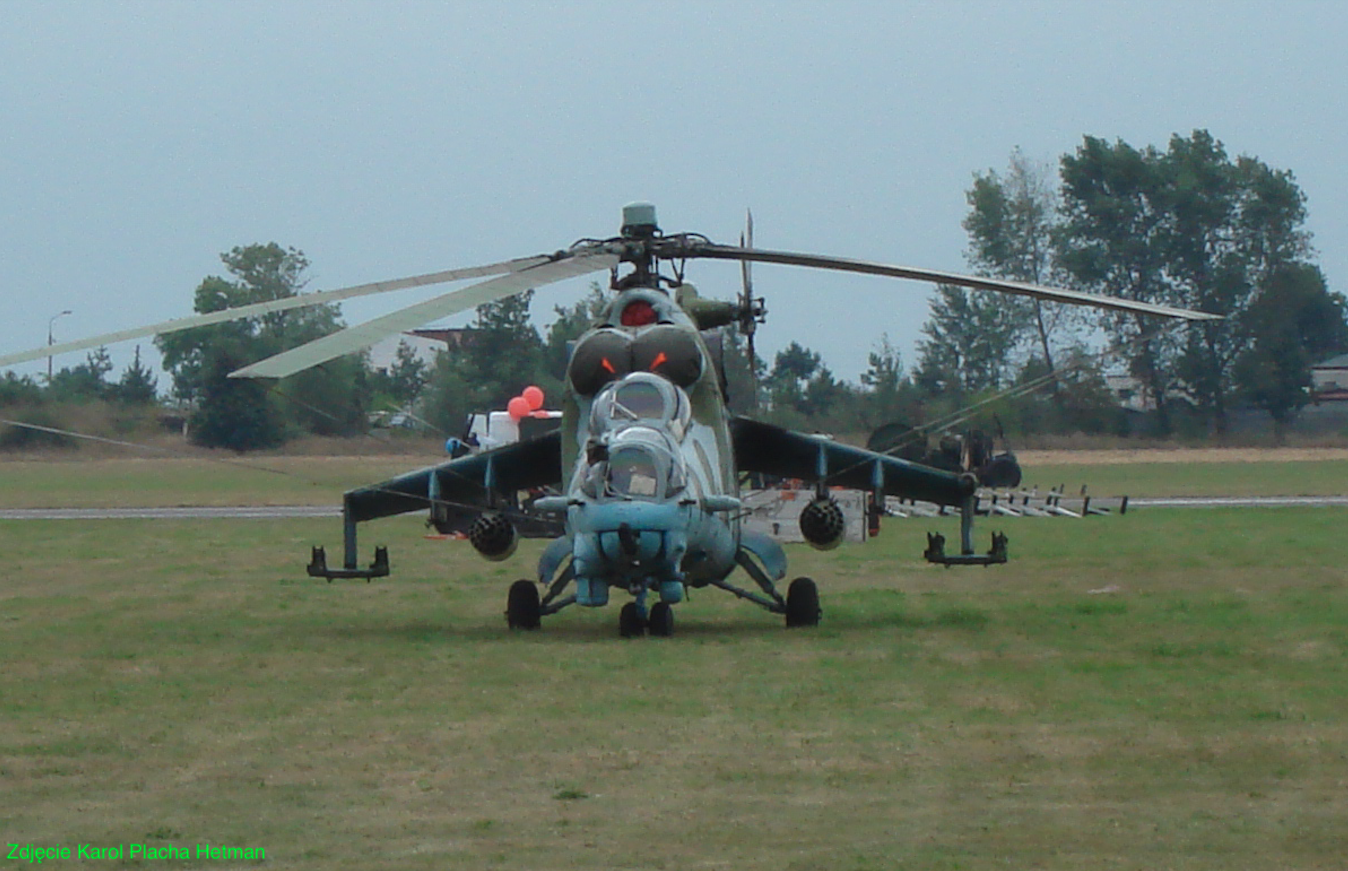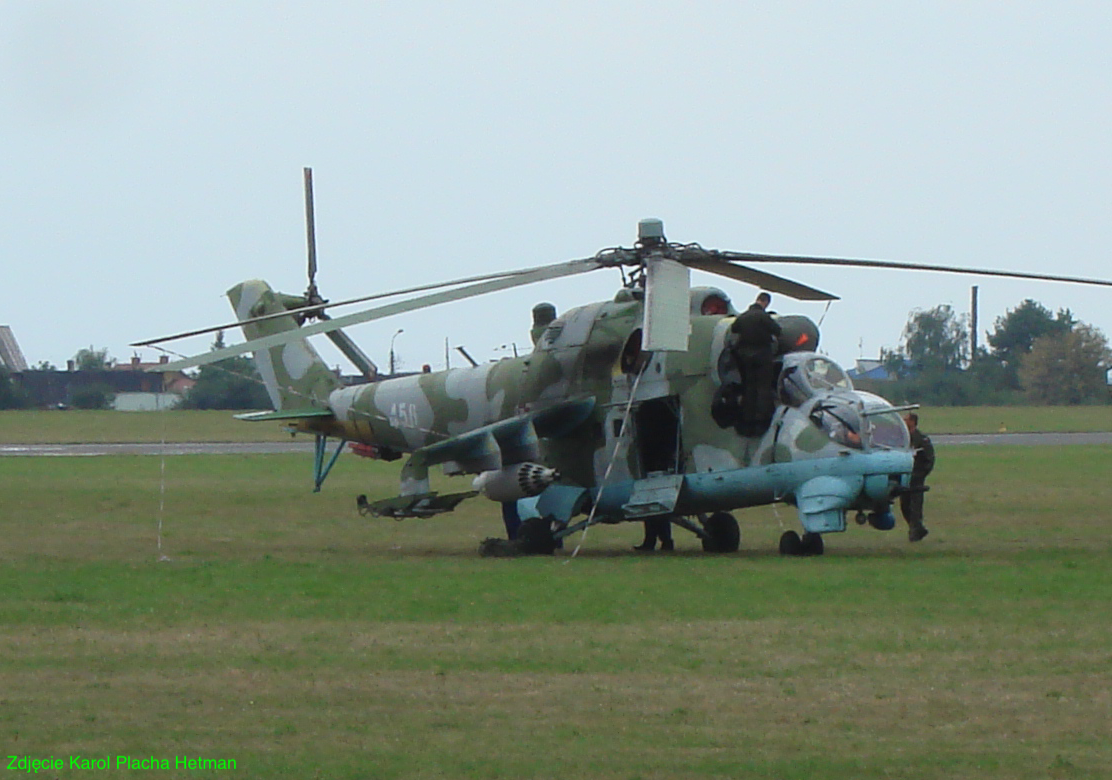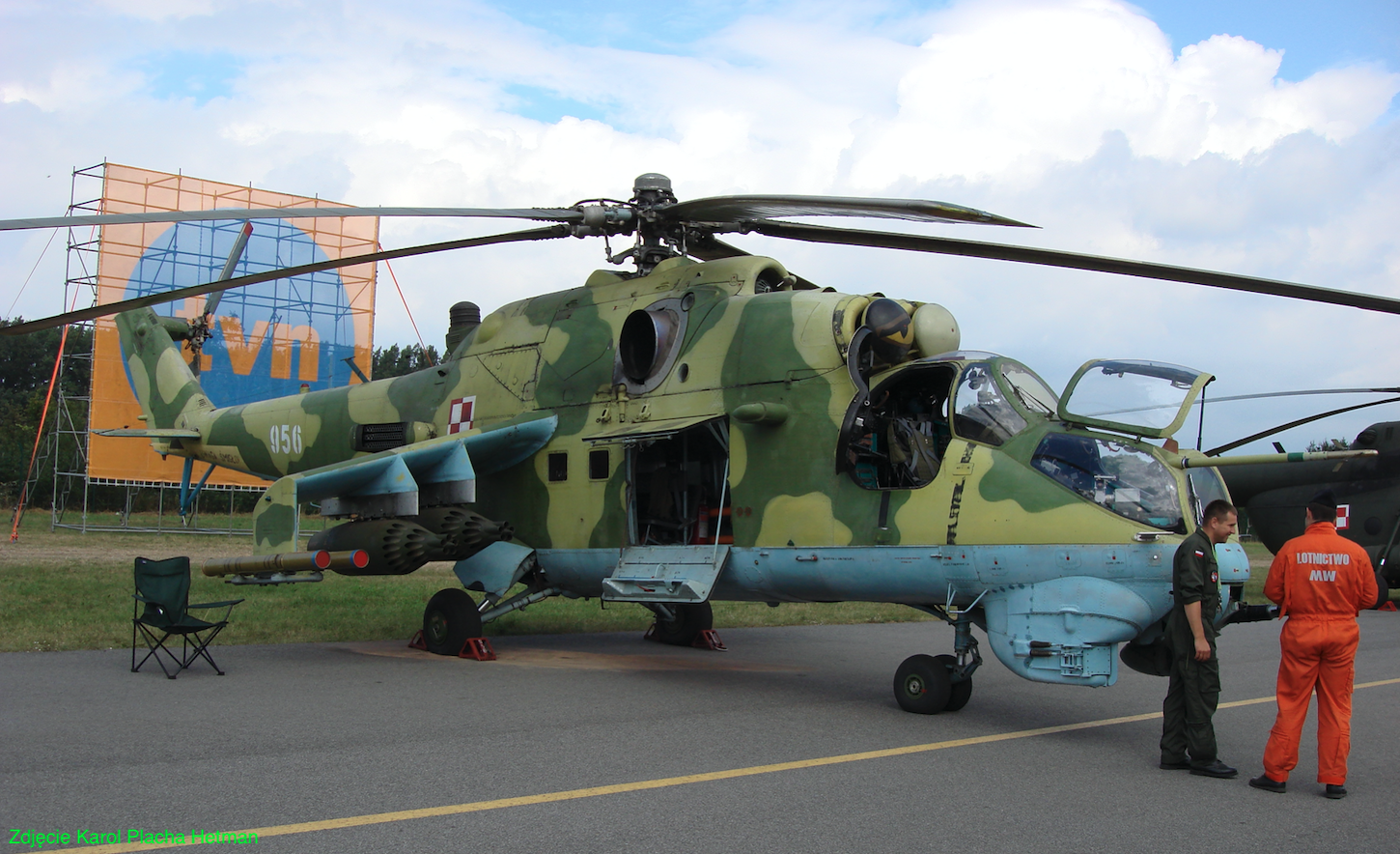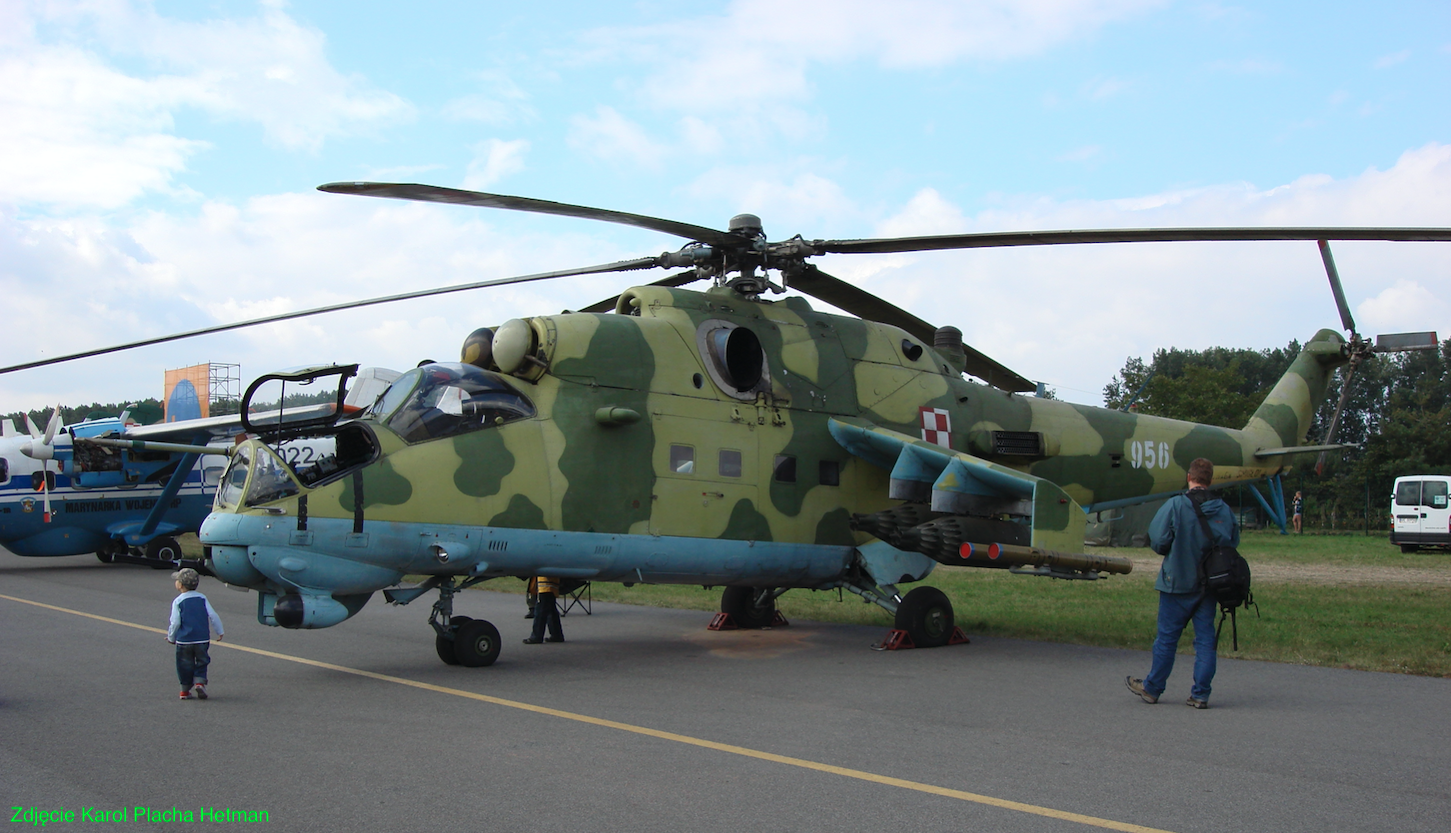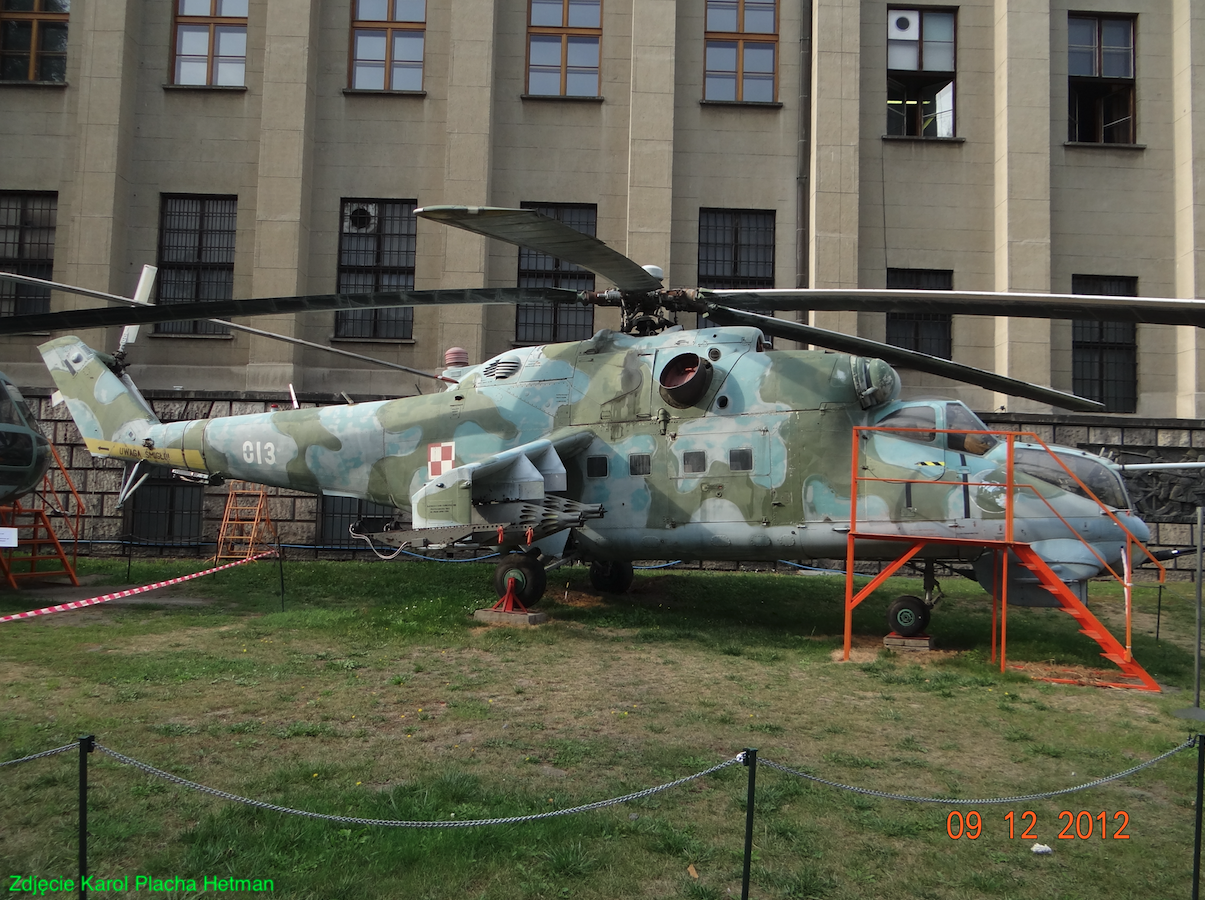Warszawa 2018-04-11
Śmigłowiec szturmowy Michaił Leontjewicz Mil Mi-24.
245a Rozdział 20.09.1978 rok. Polska.
Historia.
Rozwój konstrukcji Mi-24.
Mil Mi-24 to średni śmigłowiec szturmowy. W chwili opracowania był ewenementem wsród śmigłowców bojowych – jednocześnie pełnił funkcję typowego śmigłowca szturmowego i desantowego dla drużyny. Śmigłowiec jest przeznaczony do niszczenia celów punktowych: czołgi, stanowiska artylerii, bunkry, mosty i siła żywa przeciwnika.
Historia Mil Mi-24 rozpoczęła się pod koniec 60-lat XX wieku. Sowieci skrupulatnie zbierali informacji odnoście użycia śmigłowców podczas wojny w Indochinach. Podobnie jak Amerykanie, sowieci dostrzegli duże korzyści z użycia śmigłowców na polu walki, gdzie przeciwnik ma przewagę. Zaczęli analizować stworzenie stosunkowo uniwersalnego śmigłowca pola walki. Zadanie powierzono biuru OKB Michaiła Mila. Sam Michaił Mil był w tym czasie człowiekiem już poważnie chorym. Na czele zespołu zadaniowego stanął Marat Tiszczenko.
W opracowaniach dotyczących śmigłowca Mi-24 można znaleść określenie ciężki lub średni, co jest dużą różnicą. Ta pozorna nieścisłość wynika z interpretacji tych określeń. Jeśli brać pod uwagę śmigłowiec ten na tle wszystkich śmigłowców to jest on na pewno średni. Jednak kiedy popatrzymy tylko na śmigłowce klasy bojowej to Mi-24 jest na pewno śmigłowcem ciężkim.
Aby przyspieszyć prace nad nowym śmigłowcem sowieci postanowili wykorzystać jedną z istniejących już konstrukcji. Pod uwagę brano śmigłowiec Mi-2 oraz Mi-8. Problem w tym, że śmigłowiec Mi-2 był produkowany seryjnie tylko w Polsce w Świdniku, a nieufność CCCP do Polski była duża. Gdyby jednak sowieci oparli się na Mi-2, to powstałby śmigłowiec podobny do konstrukcji Zachodnich. Ostatecznie wybrano śmigłowiec Mi-8, z którego wykorzystano wiele podzespołów. Wśród nich; wirnik nośny i śmigło ogonowe, główna przekładnia, silniki oraz środkowa część konstrukcji kadłuba. Całkowicie przebudowano przednią część kadłuba. Pozostawiono fotele pilotów w układzie side by side. Początkowo załoga miała liczyć aż czterech lotników: dwóch pilotów i dwóch operatorów uzbrojenia. Wynikało to z układów sterowania uzbrojeniem, który wymagał śledzenia i kierowania pociskami, aż do momentu trafienia w cel. Układ tandem kabiny wprowadzono nieco później, kiedy analizy wykazały, że dwóch lotników jest w stanie skutecznie sterować śmigłowcem i jego uzbrojeniem. Dzięki układowi tandem, chciano zmniejszyć opór czołowy konstrukcji. Długo rozważano, kto powinien siedzieć pierwszy: pilot czy operator uzbrojenia. Ostatecznie pilot siedzi w drugiej kabinie. Kabina była obszerna, ale umieszczenie foteli na tym samym poziomie powodowało, że drugi lotnik miał ograniczone pole widzenia. Prace więc trwały nadal i ostatecznie zastosowano przewyższenie tylnego fotela, tak jak to czyniono już w samolotach szkolno-treningowych.
W 1969 roku, zbudowano pełnowymiarową makietę śmigłowca. Konstrukcję oznaczono W-24 (Вертолет-24). Oblot maszyny W-24 odbył się w dniu 19 września 1969 roku. Dowódcą załogi był Herman Ałfiorow. Już wówczas zdecydowano, że śmigłowiec trzeba przebudować. Pierwszą zmianą było zmniejszenie wirnika nośnego (jego średnicy). Pozwoliło to na skrócenie belki ogonowej. Dzięki temu śmigłowiec stał się zwrotniejszy. Kadłub otrzymał mniejszą średnicę. Spowodowało to ograniczenie zabieranych na pokład żołnierzy z ekwipunkiem. Poprzednio kadłub mieścił drużynę, 12 osób. Teraz tylko 8 osób. Najważniejsze elementy konstrukcji płatowca opancerzono. Dodano niewielkie skrzydła, których głównym celem było podwieszenie pod nimi uzbrojenia, ale także wzrost zasięgu.
W tym miejscu trzeba zwrócić uwagę na oznaczenia śmigłowców Mi-24. Początkowo śmigłowiec miał otrzymywać oznaczenia Mi-8 z prefiksami. Śmigłowiec Mi-24 wśród lotników sowieckich nazwano Grubasem, z uwagi na kształt kadłuba. Natomiast w NATO nadało mu nazwę, standardowo rozpoczynająca się od litery H; Hind, czyli Łania. Do nazwy Hind dodawano litery kolejnych rozpoznawanych przez Zachód wersji: A, B, C itd. W efekcie okazało się, że w literaturze przedmiotu częściej są podawane wersje typowane przez Zachód niż oznaczenia sowieckie, które są cyfrowe. W efekcie wersja Mi-24 A jest pierwszą wersją produkcyjną, a wersja Mi-24 B jest serią przedprodukcyjną. Różnice polegają tylko na zamontowaniu uzbrojenia (Mi-24 A).
Mi-24 A otrzymał ruchomy karabin maszynowy A-12,7 kal 12,7 mm. Pod skrzydłami podwieszono niekierowane pociski rakietowe. Podstawowym uzbrojeniem miały być kierowane pociski rakietowe, przeciwpancerne. Ale w tym czasie były one w fazie opracowania.
Nowy śmigłowiec, z dużą, przeszkloną kabiną, z silnikami TW2-117 A, miał bardzo dobre osiągi. Zwłaszcza prędkość postępową. Skłoniło to inżyniera Marata Tiszczenko do zbudowania egzemplarza rekordowego, który otrzymał onaczenie A-10. Na tym egzemplarzu załoga: pilot inżynier kobieta Galina Rastorgujewa i nawigator kobieta Ludmiła Polanska (zawodowo nawigator samolotu Ił-18) w 1975 roku, ustanowiła kilka rekordów FAI. Między innymi w dniu 18 lipca 1975 roku, prędkość w obwodzie 100 km wynikiem 334,464 km/h. W dniu 1 sierpnia 1975 roku, prędkość w obwodzie 500 km wynikiem 331,023 km/h. W dniu 13 sierpnia 1975 roku, prędkość w obwodzie 1 000 km wynikiem 332,646 km/h. Załoga ta ustanowiła także rekordy czasu wznoszenia. W dniu 8 sierpnia 1975 roku, 2 min 33 sek na 3 000 m. W dniu 26 sierpnia 1975 roku, 7 min 43 sek na 6 000 m. W tym czasie świadectwo do eksploatacji uzyskał silnik TW3-117. Silniki te zamontowano na A-10. W dniu 21 września 1978 roku, pilot Gienadi Karapetian uzyskał prędkość 368,400 km/h na bazie 15/25 km.
Silniki TW3-117 zamontowano w śmigłowcu seryjnym i tak powstała wersja Mi-24 C, bez uzbrojenia, przeznaczona do zadań transportowych dla wojska.
W tym czasie rozwijano systemy uzbrojenia dla śmigłowca. Starano się opracować skuteczne uzbrojenie i sposoby walki z czołgami. Rozpatrywano wykorzystanie nieruchomego działka dwulufowego kal 23 mm lub ruchomego karabinu maszynowego kal 12,7 mm (typ JaKB-12,7). Przewidywano zastosowanie systemu pocisków rakietowych o kryptonimie "Szturm". System posiadał kierowane pociski rakietowe, o prędkości naddźwiękowej Kokon 9M144 z głowicami przeciwpancernymi, o naprowadzaniu półautomatycznym, radio-komendowo. Dążono do zachowania dużej prędkość postępowej śmigłowca (minimum 315 km/h) oraz możliwość wykonywania długiego zawisu na wysokości minimum 25 m nad ziemią. Priorytetem także była duża manewrowość.
Prawdziwą rewolucją stała się najpopularniejsza wersja Mi-24 D, która weszła do uzbrojenia w 1976 roku. Śmigłowiec sprzedano krajom Układu Warszawskiego: Bułgarii, Czechosłowacji, NRD, Węgrom i Polsce. Śmigłowiec oprócz nowych silników otrzymał wiele modyfikacji. Śmigłowiec jest swoistą hybrydą maszyny szturmowej i transportowej. Transportuje ośmiu żołnierzy z pełnym ekwipunkiem. Ale co ciekawe, nie wyparł całkowicie wersji bojowych śmigłowca Mi-8/Mi-17.
Produkcja seryjna była prowadzona w Arseniewie, zakłady Nr 116 (obecnie zakłady Progress) na wschodzie CCCP. Produkcję zaczęto w 1970 roku. Kolejnym zakładem produkcyjny był Rostow nad Donem Nr 168. Produkcja Mi-24 trwała od 1970 roku do 1989 roku. Zbudowano ponad 3 000 maszyn. Śmigłowiec Mi-35 jest dalszym rozwinięciem śmigłowca Mi-24. W latach 1992-2012, zbudowano około 150 maszyn Mi-35.
Mil Mi-24 w Polsce. 1978 rok.
Decyzja o zakupie śmigłowców Mi-24 D dla Wojska Polskiego zapadła w połowie 70-lat XX wieku. W kwietniu 1978 roku, wytypowano zespół 10 pilotów i 24 techników do przeszkolenia na nową technikę na terenie CCCP. Większość Polskiego personelu pochodziła z 37. Pułku Śmigłowców Transportowych, Leźnica Wielka koło Łęczycy. Szkolenie trwało cztery miesiące.
Pierwsze cztery śmigłowce Mi-24 D trafiły do Polski w dniu 20 września 1978 roku. Śmigłowce miały Nr: A1013, A1014, A1015, A1016. Przyprowadzili je piloci sowieccy. Śmigłowcom nadano odpowiednie nb 13, 14, 15, 16. Początkowo śmigłowce pozostawały na ziemi, bo szkolenie personelu Polskiego jeszcze się nie zakończyło.
Pierwszy klucz śmigłowców Mi-24 D zaczął oficjalnie funkcjonować od dnia 1 stycznia 1979 roku. Na stanowisko dowódcy klucza mianowano podporucznika pilota Andrzeja Fryc. Loty rozpoczęto w dniu 11 stycznia 1979 roku, z chwilą poprawy warunków atmosferycznych. Pierwszy etap szkolenia zakończono stosunkowo szybko. W dniu 22 kwietnia 1979 roku, klucz śmigłowców Mi-24 D przebazowano na Lotnisko Świdwin i rozpoczęto szkolenie bojowe, korzystając z pobliskich poligonów. Gotowość bojową osiągnięto już w połowie 1979 roku. Śmigłowce Mi-24 D wzięły udział w jesiennych ćwiczeniach wojskowych „Jubileusz 79”.
Mi-24 D po raz pierwszy publicznie zaprezentowano w dniu 27 czerwca 1979 roku, na Lotnisku Dęblin z okazji pierwszej rocznicy lotu kosmicznego Mirosława Hermaszewskiego (1941 – 2022).
Umieszczenie śmigłowców bojowych Mi-24 w Leźnicy Wielkiej, gdzie stacjonowały śmigłowce transportowe było nielogiczne. Dlatego eskadrę przebazowano do 49. Pułku Śmigłowców Bojowych (Pruszcz Gdański).
Kolejne cztery śmigłowce Mi-24 D (nr 103174, 103175, 103176, 103177) przyleciały do Polski w dniu 20 października 1981 roku, lądując na Lotniku Pruszcz Gdański. W październiku 1984 roku, do 49. Pułku Śmigłowców Bojowych (Pruszcz Gdański) dostarczono sześć śmigłowców (Nr 410456, 410457, 410458, 410459, 410460, 410461). W dniu 1 lipca 1985 roku, dostarczono ostatnie dwie maszyny Mi-24 D; Nr 410584 i 410585.
Kolejne śmigłowce należały już do wersji Mi-24 W. Wersja śmigłowca Mi-24 W od poprzedniej Mi-24 D różni się przede wszystkim systemem uzbrojenia kierowanego (przenosi osiem pocisków 9K114 Szturm-W), a co za tym idzie wyposażeniem bojowym. Pierwsze cztery maszyny przyleciały do Polski w dniu 24 kwietnia 1986 roku. Łącznie zakupiono 16 maszyn Mi-24 W, które trafiły do 56. Pułku Śmigłowców Bojowych (Lotnisko Inowrocław).
Ostatnie egzemplarze pozyskano już po 1989 roku, po przemianach społeczno-gospodarczych. W połowie 90-lat od niemców otrzymaliśmy nieodpłatnie 18 maszyn Mi-24 D, wcześniej użytkowanych w NRD. Ponieważ były one w złym stanie, wykonano przeglądy i naprawy w WZL-1. Udało się naprawić 16 maszyn. Dwie maszyny posłużyły jako źródło części zamiennych. Weszły one na stan 49. PŚB Pruszcz Gdański. Pierwszy ex niemiecki Mi-24 D trafił do służby w dniu 23 października 1996 roku.
Bazami Polskich śmigłowców Mi-24 standardowo jest Pruszcz Gdański i Inowrocław. Jednak bardzo często śmigłowce Mi-24 bazują na Lotnisku Nowy Trag. Tutaj załogi korzystają z możliwości ćwiczeń w warunkach górzystych. Polskie Mi-24 działały w Iraku i Afganistanie.
Polscy piloci śmigłowców Mi-24 D/W oceniali je pozytywnie. „Przez 6 lat byłem pilotem tej maszyny, mimo że z wyglądu wydaje się być ciężką i nieporadną, w powietrzu zachowuję się wspaniale, szczególnie lubiłem szybki lot tuż nad drzewami lub w wąskich dolinach – niesamowite wrażenie, no i ta siła ognia. Wyposażane w coraz lepszą awionikę i uzbrojenie , a przy tym prostota obsługi w polowych warunkach – chyba długo jeszcze będą służyć.”
Jednak obecnie, 2017 roku, wartość bojowa Polskich Mi-24 jest niższa od tej przed 2012 rokiem. Po prostu Polskie śmigłowce nie dysponują kierowanymi pociskami rakietowymi. Wszystkie posiadane przez Polskę pociski zostały użyte. Śmigłowce Mi-24 D przenosiły cztery pociski systemu Falanga, o nazwie Skorpion. Zasięg pocisków 3 000 m. Natomiast śmigłowce Mi-24 W przenosiły osiem pocisków 9K114 Szturm-W. Zasięg pocisków 5 000 m. Warto zaznaczyć, że nie jest to problem wyłącznie śmigłowców Mi-24, ale wszystkich bojowych maszyn w Polsce. Odpowiedzialność za ten stan rzeczy spada na masońsko-liberalny rząd Polski z premierem Donaldem Tuskiem, który prowadził politykę likwidacji państwa. Dopiero od 2016 roku, podjęto ramowe rozwiązanie problemu. Albo nowe śmigłowce z nowym uzbrojeniem, albo nowi dostawcy pocisków rakietowych. W uzbrojeniu Polskich Mi-24 pozostają działka 23 mm, działka cztero-lufowe 12,7 mm oraz niekierowane pociski rakietowe.
Opracował Karol Placha Hetman

